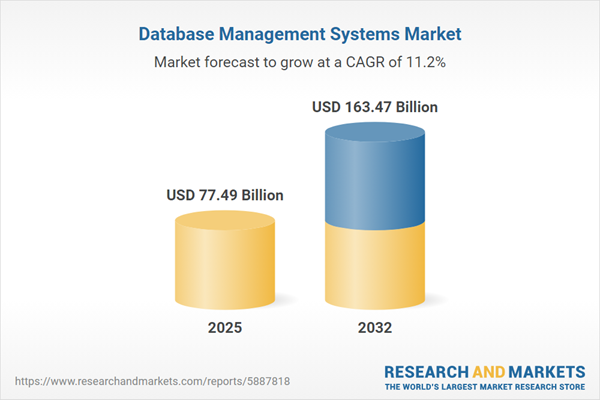Speak directly to the analyst to clarify any post sales queries you may have.
The database management systems market empowers enterprises to achieve operational efficiency and innovation, supporting adaptable IT environments and helping leaders confidently respond to evolving digital demands.
Market Snapshot: Database Management Systems Market Trends
The database management systems market is experiencing significant expansion, reflecting rising priorities for real-time data access and robust data security. In 2024, this market achieved USD 70.04 billion in revenue, with an anticipated increase to USD 77.49 billion in 2025, marking a compound annual growth rate (CAGR) of 11.17%. Projections for 2032 suggest the sector may reach USD 163.47 billion, indicating substantial investments in next-generation data platforms. These trends show that organizations, facing increasing operational complexity and compliance needs, are modernizing infrastructures to remain competitive in fast-changing digital landscapes.
Scope & Segmentation of the Database Management Systems Market
- Database Types: In-memory, NewSQL, NoSQL (covering columnar, document, and graph databases), and traditional relational systems offer distinct benefits and reliability for varying enterprise workloads.
- Pricing Models: Allow license-based, subscription-based, and usage-based expenditures, helping organizations optimize database spending and align investments with business priorities.
- Technological Integration: Leverage artificial intelligence, big data analytics, blockchain, and machine learning to automate processes, drive performance improvements, and extract deeper insights.
- Deployment Models: Cloud and on-premises solutions support flexible strategies that balance regulatory compliance, IT control, and scalability, responding to unique enterprise requirements.
- Organization Size: Platforms are tailored for both large enterprises and small to medium businesses, addressing differing resource allocations and growth ambitions.
- Applications: Support for transactional and analytical workloads, efficient data storage, as well as powerful data warehousing and timely business intelligence provisioning.
- End Users: Sectors such as banking and finance, education, government, healthcare, IT and telecommunications, manufacturing, and media each bring specific operational and compliance demands.
- Regional Markets: The Americas, Europe, Middle East & Africa, and Asia-Pacific play essential roles through policy, regulation, and digital priorities shaping adoption and vendor strategies.
- Leading Companies: Vendors include Altibase Corp., Amazon Web Services, Cloudera, Couchbase, Datadog, DbVis, ForeSoft, Google LLC, Idera, IBM, JFrog, MariaDB, Microsoft, MongoDB, Neo4j, Oracle, PremiumSoft CyberTech, Quest Software, Redis, Richardson Software, Salesforce, SAP SE, Sequel Pro, Snowflake, Softonic International, SolarWinds, TablePlus, Teradata, PostgreSQL Global Development Group, and Zoho Corporation, reflecting the market’s broad technology landscape.
Key Takeaways for Senior Decision-Makers
- Managing both transactional and analytical workloads enhances agility and organizational responsiveness to changing business pressures.
- Employing artificial intelligence and machine learning within database environments improves operational efficiency and system performance.
- Choosing hybrid and multi-cloud deployments delivers greater resilience and flexibility to better address regulatory and market dynamics.
- Adaptive pricing structures allow for precise financial planning and alignment of spending with actual enterprise needs.
- Industry-specific compliance and security considerations drive demand for bespoke database solutions, particularly within finance, healthcare, and manufacturing environments.
- Building strategic partnerships and adopting secure database ecosystems sustain enterprise competitiveness in dynamic industry conditions.
Tariff Impact on Enterprise Database Strategies
Anticipated United States tariffs in 2025 are requiring enterprises to rethink IT procurement and deployment models. Increased hardware costs linked to shifting trade policies are leading organizations to diversify sourcing and strengthen local vendor connections. Enterprises are also maximizing the value of software investments, seeking alternate licensing arrangements, and enhancing supply chain flexibility to safeguard operations against possible disruptions. This adaptive approach is becoming integral to maintaining business continuity as regulatory requirements evolve.
Methodology & Data Sources
This analysis combines both qualitative and quantitative methods, including desk research, expert interviews, and triangulated data validation. Advanced techniques such as cluster analysis and scenario modeling, reviewed by subject matter specialists, underpin the conclusions presented.
Why This Report Matters for Strategic Leaders
- Enable effective technology investment decisions by offering clear analysis of modernization and platform trends, supporting sustainable organizational growth.
- Ensure proactive infrastructure planning by providing guidance on navigating evolving regulatory and trade landscapes in database procurement and compliance.
- Support confident platform and vendor selection using comprehensive market assessments and solution comparisons tailored to enterprise workflows.
Conclusion
Staying informed on database management system developments and prioritizing flexible, secure infrastructure is vital for risk mitigation and long-term adaptability. This report delivers actionable guidance to strengthen decision-making and support resilient enterprise growth.
Additional Product Information:
- Purchase of this report includes 1 year online access with quarterly updates.
- This report can be updated on request. Please contact our Customer Experience team using the Ask a Question widget on our website.
Table of Contents
3. Executive Summary
4. Market Overview
7. Cumulative Impact of Artificial Intelligence 2025
Samples

LOADING...
Companies Mentioned
The key companies profiled in this Database Management Systems market report include:- Altibase Corp.
- Amazon Web Services, Inc.
- Cloudera, Inc.
- Couchbase, Inc.
- Datadog, Inc.
- DbVis Software AB
- ForeSoft Corporation
- Google LLC
- Idera, Inc.
- International Business Machines Corporation
- JFrog Ltd.
- MariaDB Foundation
- Microsoft Corporation
- MongoDB, Inc.
- Neo4j, Inc.
- Oracle Corporation
- PremiumSoft CyberTech Ltd.
- Quest Software Inc.
- Redis Ltd.
- Richardson Software, LLC
- Salesforce, Inc.
- SAP SE
- Sequel Pro
- Snowflake Inc.
- Softonic International S.A.
- SolarWinds Worldwide, LLC
- TablePlus Inc.
- Teradata Operations, Inc.
- The Postgresql Global Development Group
- Zoho Corporation Pvt. Ltd.
Table Information
| Report Attribute | Details |
|---|---|
| No. of Pages | 183 |
| Published | October 2025 |
| Forecast Period | 2025 - 2032 |
| Estimated Market Value ( USD | $ 77.49 Billion |
| Forecasted Market Value ( USD | $ 163.47 Billion |
| Compound Annual Growth Rate | 11.1% |
| Regions Covered | Global |
| No. of Companies Mentioned | 31 |









